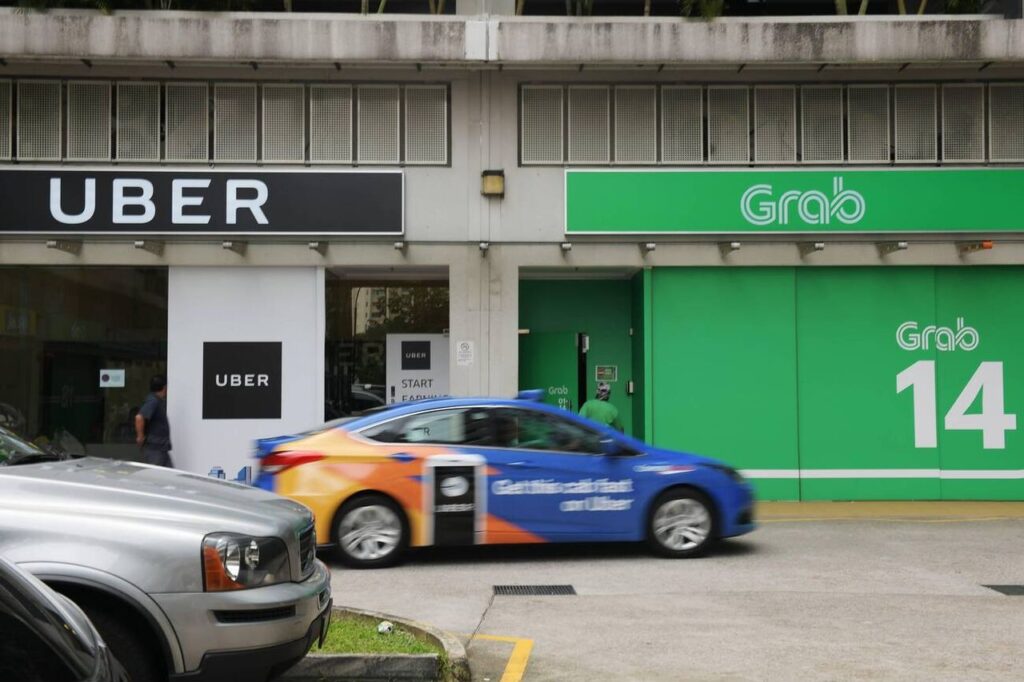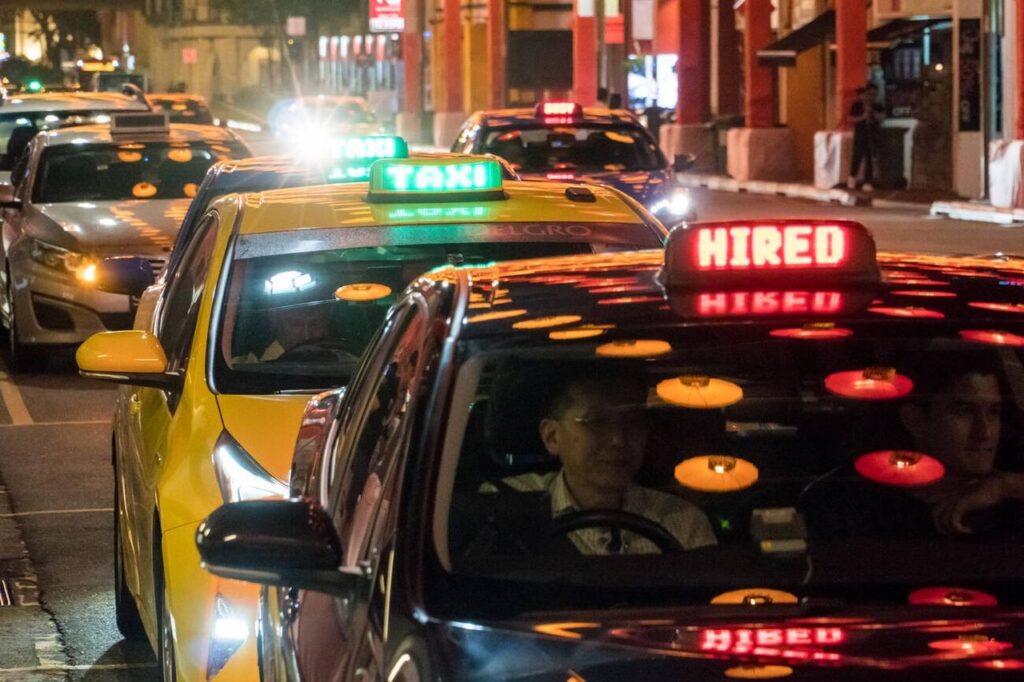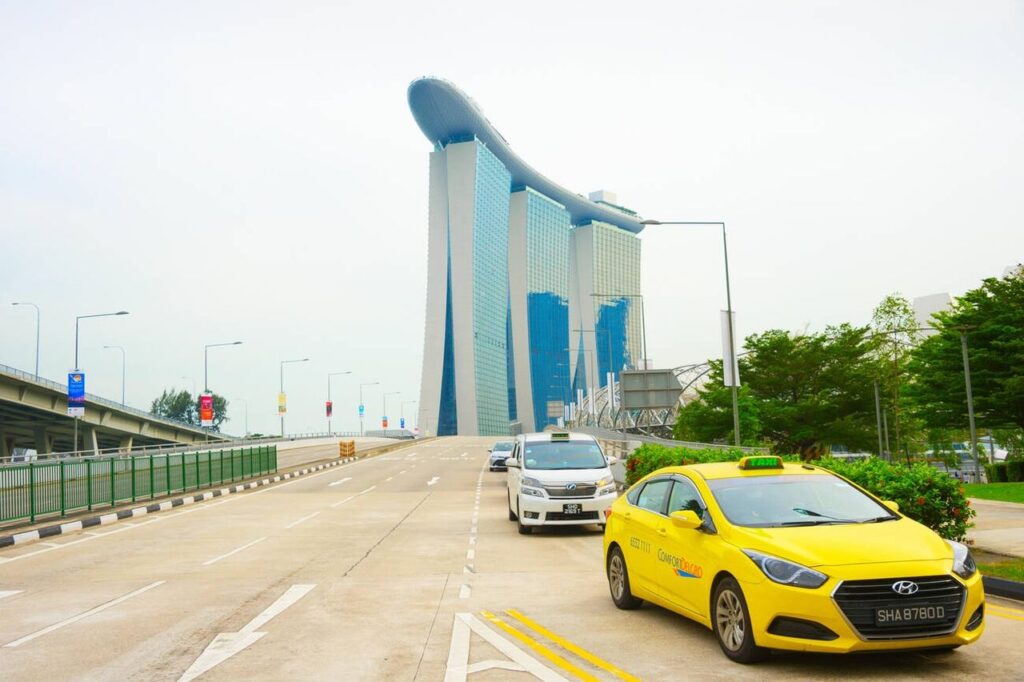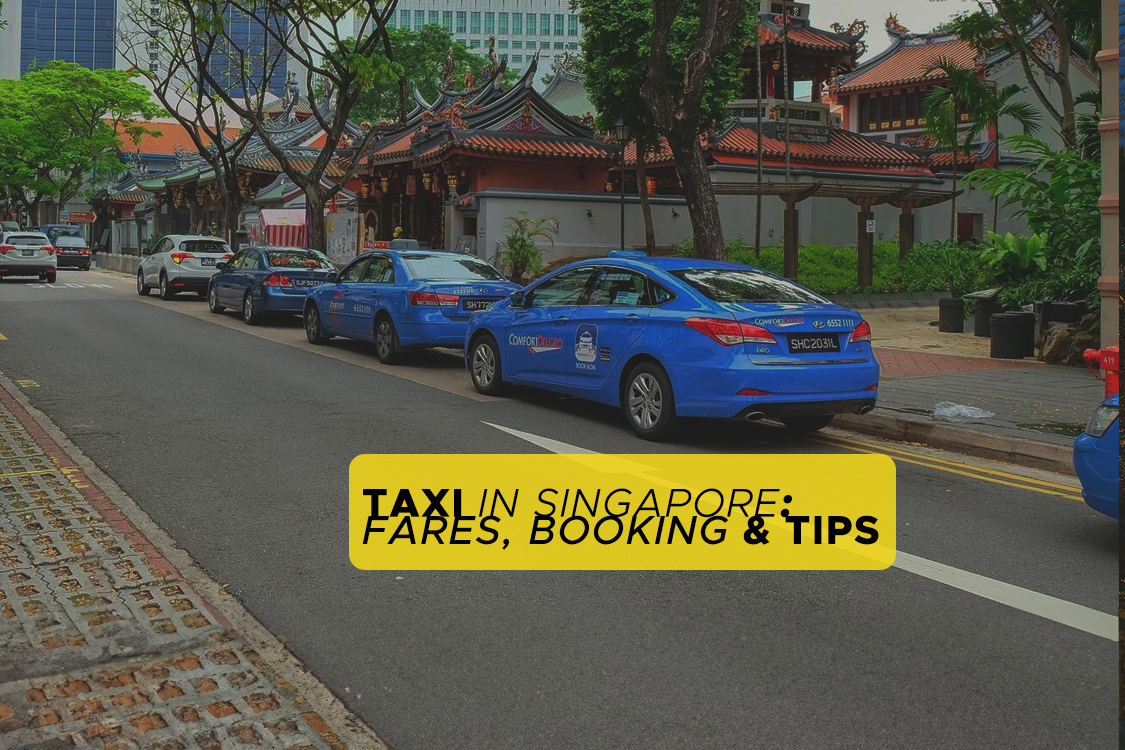Exploring the dynamic cityscape of Singapore often brings travelers to a common crossroad: the choice between traditional taxis and Private Hire Cars (PHCs). This essential guide delves into the intricacies of navigating Singapore’s roads, offering insights into fares, booking tips, and a comprehensive look at the city’s taxi landscape in 2024. Whether you’re rushing to a business meeting or embarking on a leisurely tour, understanding your transport options is key to a seamless Singapore experience.
Traditional Taxis in Singapore: A Closer Look
Singapore’s streets are lined with a variety of taxis, from standard cabs to premium and limousine services, catering to different needs and preferences. Here’s what you need to know:
- Standard Taxis: These vehicles are the backbone of Singapore’s taxi fleet, primarily comprising mid-range models from Toyota, Hyundai, and Kia. The flagfall ranges from S$3 to S$3.50, covering the first kilometer, with subsequent charges of 22 cents per 400 meters.
- Premium Taxis and Maxicabs: For groups or those requiring more space, these seven-passenger vehicles offer a starting flagfall of S$3.90, with the same incremental fare as standard taxis. An additional S$2 per head is charged for more than four adult passengers.
- Limousine Taxis: For a touch of luxury, these taxis, mainly Mercedes-Benz and Chrysler models, start with a flagfall of S$3.90 to S$5, with distances charged between 22 cents to 33 cents per 400 meters. They’re ideal for those looking for a more comfortable and stylish ride.
Regardless of the type, taxis in Singapore are regulated, ensuring clean, well-maintained vehicles and professional drivers. For those landing at Changi Airport, metered airport taxis provide direct transfers to hotels, simplifying the first leg of your journey in Singapore.
Private Hire Cars (PHC): Taxi Apps
The rise of PHCs, led by operators like Grab and Gojek, has transformed urban transport in Singapore. PHCs, identifiable by their blue “Private Hire” decal, offer a modern alternative to traditional taxis, with some key differences:
- Booking: Unlike taxis, PHCs must be booked via mobile apps, offering convenience and the ability to track your ride’s arrival.
- Car Seats: A notable distinction, PHCs require car seats for young passengers, aligning with Singapore’s stringent safety regulations.
- Fares: While taxis typically run on a meter, PHCs often provide a fixed fare upfront, eliminating fare surprises at the end of your journey.
Taxi vs PHC: Making the Right Choice
When deciding between a taxi and a PHC, consider your specific needs. Taxis offer the flexibility of hailing on the street and are readily available at taxi stands, making them a convenient option for spontaneous trips. On the other hand, PHCs provide a predictable fare and the convenience of booking through an app, ideal for planned journeys and those preferring a more straightforward payment process.

Private Driver Hire for a Day
For those who wish to explore Singapore at their own pace and with the ultimate convenience, the option of renting a private car or minibus with a driver for a full day is an excellent choice. This service, such as the one offered by Singapore: 8 Hours – Private Car or Minibus Rental with Driver, provides a seamless and personalized travel experience, allowing you to discover Singapore’s marvels without the hassles of public transportation or navigating through traffic.
For travelers seeking convenience and flexibility in Singapore, the option of renting a private car or minibus with a driver for a full day offers a personalized and efficient way to explore the city. This service, such as the one highlighted by Singapore: 8 Hours – Private Car or Minibus Rental with Driver, allows visitors to design their own itinerary, visiting attractions like the Buddha Tooth Relic Temple & Museum at their own pace, with the added convenience of door-to-door service from their hotel.
Advantages of Private Car or Minibus Rental:
- Customizable Itinerary: Tailor your day to your interests, ensuring you see what you want without being tied to public transport schedules.
- Ease and Comfort: Enjoy the ease of getting picked up and dropped off at your hotel, avoiding the hassle of navigating public transportation.
- Maximized Time: With a dedicated vehicle, you can cover more attractions in less time, making the most of your stay in Singapore.
- Local Insight: Benefit from your driver’s knowledge for the most efficient routes and local tips.
Booking Your Ride:
Booking is simple and can be done online in advance, allowing you to plan your day according to your preferences and ensuring a hassle-free experience upon arrival in Singapore.
Don’t Miss The Best Tours in Singapore
How to Find a Taxi in Singapore?
Here’s a comprehensive guide on securing a ride in this vibrant city-state.
1. Hailing a Taxi Along the Road
While spontaneity in catching a taxi directly off the street appeals to many, Singapore’s rules necessitate a more nuanced approach, especially within the CBD.
- In the CBD: The bustling heart of Singapore, encompassing areas like Tanjong Pagar, Marina Bay, and Orchard, has specific regulations. Here, you cannot hail a taxi directly off the street. This rule aims to reduce congestion and ensure pedestrian safety.
- Outside the CBD: The rest of Singapore is more flexible, allowing passengers to flag down taxis. However, certain restrictions apply, such as avoiding bus stops, lanes with zigzag lines, bus lanes during operating hours, and expressways.
When trying to hail a taxi, look for the illuminated sign on the taxi’s roof:
- Green “TAXI” Sign: Indicates availability.
- Red “HIRED” Sign: The taxi is occupied.
- Location Name Displayed: The taxi is headed to a specific destination but may still pick up passengers en route.

2. Waiting for a Taxi at Taxi Stands or Designated Locations
For a more structured approach, taxi stands and designated pickup points offer a reliable alternative. These are strategically located at malls, hotels, and public attractions, ensuring a steady flow of cabs. If you find yourself at a quieter stand, consider other options like mobile apps or phone bookings.
3. Booking a Taxi via Mobile App
The digital age brings the convenience of app-based bookings, with ComfortDelGro’s CDG Zig app leading the way in Singapore. This app allows users to:
- Specify pickup and drop-off locations.
- Choose the taxi size.
- Select fare type: fixed or metered.
This method not only streamlines the booking process but also allows you to wait comfortably at your location until your ride arrives.
4. Booking a Taxi by Calling
For those without internet access or preferring a more traditional approach, calling a taxi company is a viable option. While booking fees apply, this method ensures you can still secure a ride. Here are the numbers for Singapore’s main taxi operators:
- Comfort / City Cab: 6552 1111
- Premier Taxi: 6363 6888
- TransCab: 6555 3333
- Prime Taxi: 6778 0808
- Strides Taxi: 6555 8888
Booking a Grab, Gojek, Tada, or Ryde in Singapore
To book a ride with any of these PHCs, you’ll need to download their respective apps:
- Grab
- Gojek
- Tada
- Ryde
Remember, PHCs cannot be hailed directly from the street. Once you book a ride through the app, you will be assigned a designated pick-up point, often away from taxi stands or bus stops, to meet your driver. It’s important to arrive at the pick-up point on time, as PHC operators may impose additional fees for waiting beyond the allotted time.

How to Pay for Taxis in Singapore
When it comes to settling the fare for your taxi ride in Singapore, you have multiple options:
- Cash: Universally accepted and straightforward.
- Debit/Credit Cards: An admin fee of 10% on the taxi fare plus a 9% GST on the admin fee is applied, making this a pricier option.
- Digital and Mobile Payments: Including EZ-Link, NETS, NETSPay, NETS Flashpay, DBS PayLah!, OCBC PayAnyone, UOB TMRW, Alipay, and WeChat Pay, with a more reasonable admin fee of S$0.30.
For those looking to avoid the steep admin fees associated with card payments, booking through the CDG Zig app and opting for a fixed fare is a savvy alternative. However, it’s worth noting that fixed fares are subject to dynamic pricing, which can fluctuate based on demand and supply, rather than distance traveled.
Navigating Singapore’s transportation options with young children or pets requires an understanding of specific regulations, particularly concerning car seat requirements for taxis and Private Hire Cars (PHCs), as well as the guidelines for traveling with pets. Additionally, being aware of the tariff system and potential supplements can help in planning your travel budget more effectively.
Car Seat Requirements in Taxi and PHC
Taxi:
- Taxis in Singapore offer a bit of leniency regarding car seat requirements; they are exempt. However, there’s a crucial caveat for children below 1.35 meters in height: they must occupy the rear seats of the vehicle for safety reasons.
PHC:
- PHCs adhere to stringent car seat regulations to enhance child safety during rides:
- Newborn to 2 years old: Must be secured in a rear-facing car seat.
- 2 to 5 years old: Should be placed in a front-facing car seat.
- Above 5 years and shorter than 1.35 meters: Must use a booster seat.
- All children below 1.35m: Are required to ride in the back of the car.
Special services like Grab Family and GoCar Kids cater to families with children, providing appropriate seating for kids aged 1 to 7 and 4 to 7 years old, respectively.
Pet Requirements in Taxi and PHC
Taxi:
- Pets are permitted in taxis provided they are either caged or muzzled, with an exception made for guide dogs for the visually impaired.
PHC:
- For pet owners, certain PHCs like Grab Pet offer pet-friendly vehicle options, ensuring a smooth ride for your furry friends.
Read Also: MRT in Singapore: Transport Guide for Tourists 2024
Understanding Tariffs and Supplements: Taxi Fares in Singapore
Singapore’s taxi tariffs are designed to be transparent, allowing passengers to estimate their fares ahead of time:
- Minimum Fare and First Kilometer: S$3.90, a baseline cost for initiating any trip.
- Subsequent Distance Charges: S$0.25 for every 400 meters up to 10 km, and beyond 10 km, the charge is the same for every 350 meters.
- Waiting Time: Every 45 seconds of waiting or slow traffic incurs a charge of S$0.25.
Supplements to Be Aware Of:
- Rush Hour: Applies during peak morning and evening times on weekdays and Saturday evenings, adding 25% to the base fare.
- Night Fare: A 50% increase over the base fare to accommodate the higher demand and lower availability of cabs at night.
- Specific Location Supplements: Including the Financial District during weekday evenings, the Airport, and Marina Bay Sands, each carrying an additional charge to the fare.
Components of Taxi Fares in Singapore
- Booking Fee: This is applied when you reserve a taxi via phone or app, ranging from S$2.30 to S$4.50, varying by the taxi operator and booking time.
- Flag Down Fee: The initial charge as you enter the taxi, whether hailed on the street or acquired at a taxi stand, is between S$4.10 and S$5.00. This fee kick-starts your fare.
- Distance Fare/Time-Based Unit Fare: These are the core of your taxi fare, calculated either by the distance covered during your trip or the time spent in the taxi, which can vary among different taxi companies.
- Surcharge Fee: Additional charges based on travel time and location. These include:
- Midnight Surcharge: An extra 50% of the metered fare from midnight to 5:59 am.
- Peak Hour Surcharge: An additional 25% during morning and evening peak hours on weekdays, and specific times on weekends and public holidays.
- Location Surcharge: Extra fees for pickups from high-demand areas like the city area, Changi Airport, and tourist attractions.
- ERP Fee: The Electronic Road Pricing fee is Singapore’s toll charge for using certain congested roads during peak hours, similar to a toll fee.
- Admin Fee: A charge for using specific payment methods, such as a 10% administration fee for credit card payments.
Why the Additional Fees?
The additional fees in Singapore’s taxi fares are reflective of the city-state’s efforts to manage road congestion, ensure availability of taxis during peak demand times, and cover the costs associated with different payment processing methods. These charges encourage efficient use of the taxi fleet and help to allocate taxis to areas and times of high demand more effectively.
Estimating Your Taxi Fare
Given the variables involved, the cost of a taxi ride in Singapore can fluctuate significantly. For example, a trip from Changi Airport to the city center during daytime could range between S$30 to S$50, depending on the specific route, traffic conditions, and any applicable surcharges.

Local Tips for Navigating Singapore by Taxi
Understanding Taxi Capacity
- Standard Taxis: These are limited to 4 adults or variations with children (under the age of 12), such as 3 adults and 2 children. It’s essential not to exceed these limits for safety reasons and to comply with regulations. Attempting to negotiate with drivers to accommodate more passengers is not advisable.
- 7-Seater Taxis: For larger groups, opt for a 7-seater taxi, which can comfortably accommodate more complex combinations of adults and children. This option ensures that everyone travels together without compromising on comfort or safety.
Luggage and Assistance
It’s common practice in Singapore for passengers to load their luggage into the taxi’s trunk. Many drivers do not offer assistance with luggage, so it’s best to be prepared to handle your items.
Providing Your Destination
To avoid confusion and ensure efficiency, provide the full address or postcode of your destination. Taxi drivers typically input this information into their GPS devices, as building names may not always be recognized.
Dealing with Refusals
If a driver refuses your fare because your destination does not align with their intended route, try not to take offense. This practice is relatively common in Singapore, and the best course of action is to simply exit the taxi and wait for another.
Choosing Your Taxi
If you’re at the front of a taxi queue and the next available taxi is a more expensive limousine service, but you prefer a budget-friendly option, you have the right to wait for a standard taxi. Communicating with fellow passengers in the queue can also help manage expectations and preferences.
Route Preferences
Some drivers may ask for your route preference. Using a navigation app like Google Maps can help you suggest an optimal route. However, most drivers aim to choose the best route based on their knowledge, even though their GPS devices might not offer the most updated path.
Managing Costs
For those wary of potentially longer routes and the associated costs, booking a taxi through apps like CDG Zig or Grab/Gojek allows for a fixed fare option. This approach can provide peace of mind by offering a predetermined cost, though it’s important to remember that prices can fluctuate based on demand and supply.
Conclusion: Taxi in Singapore
Whether opting for the traditional charm of Singapore’s taxis or the modern convenience of PHCs, travelers are well-equipped with options. By understanding the nuances of each service, visitors can navigate the city with ease, ensuring a smooth and enjoyable Singaporean adventure.
If You Liked Our Article About Taxi in Singapore & Grab, You Also Might Like
- Public Buses in Singapore: Transport Guide for Tourists 2024
- MRT in Singapore: Transport Guide for Tourists 2024
- How to Get from Changi Airport to Singapore: Transport Options 2024
- Singapore Tourist Pass, EZ-link & More: Transport Cards 2024
- Singapore Cable Car: Tickets, Hours & Routes 2024
Don’t Miss The Best Tours in Singapore
